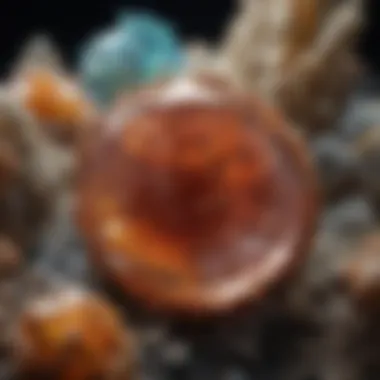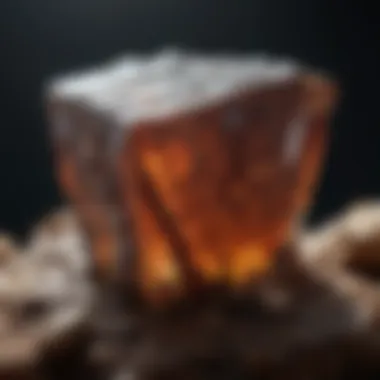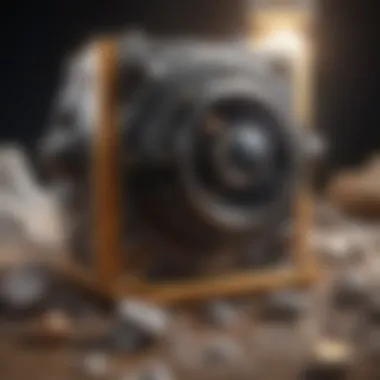Unveiling the Diverse Methods for Testing Minerals in Detail


Rock and Fossil Identification
When delving into the realm of testing minerals, a crucial initial step is rock and fossil identification. Understanding the types of rocks and fossils is essential for collectors and enthusiasts alike. By knowing the characteristics to look for in these specimens, individuals can discern valuable insights into their origins and compositions. Moreover, having the right tools for identification, such as magnifying glasses and hardness scales, can aid in the precise categorization of minerals.
Collecting Tips and Techniques
For those passionate about collecting minerals, adopting best practices is paramount. Tips on locating prime collecting sites can significantly enhance one's chances of finding rare specimens. Additionally, knowing how to safely extract specimens ensures both the preservation of the minerals and the safety of the collector. By following these techniques diligently, collectors can build impressive and diverse collections over time.
Preservation and Display
Preservation plays a crucial role in maintaining the quality of rocks and fossils in a collection. Employing techniques like proper cleaning methods and storage procedures can prolong the lifespan of these specimens. Moreover, utilizing creative display ideas not only showcases the beauty of the minerals but also allows for easier appreciation by onlookers. Balancing preservation with an aesthetically pleasing display is key for both personal satisfaction and public engagement.
Geological Insights
To truly grasp the significance of minerals, understanding geological formations and processes is imperative. Recognizing the historical context and significance of rocks and fossils adds layers of depth to one's collecting pursuits. Exploring notable discoveries in the field provides valuable insights into the earth's natural history and the scientific advancements made through mineral studies.
Introduction
In the vast realm of mineralogy, the methods employed to test minerals are pivotal in unraveling the mysteries concealed within earthly specimens. This article embarks on a journey to elucidate the diverse techniques utilized for mineral testing, catering to the discerning audience of rock and fossil collectors, geology aficionados, and science educators. By delving into this subject, readers will glean indispensable knowledge essential for identifying and comprehending the intricacies of assorted mineral specimens.
Through a meticulous examination of visual cues, mineral testing unveils a world of colors, crystal formations, and lustre variations, providing valuable insights into the unique characteristics of each specimen. Unveiling the subtle differences in color, scrutinizing the geometry of crystal structures, and assessing the shine of minerals open pathways to understanding their composition and origins.
Moreover, the meticulous streak test serves as a fundamental pillar in mineral evaluation, offering clues about the true hue of minerals when powdered. By analyzing the streak left by minerals against different materials, enthusiasts can infer essential information about mineral hardness and composition, contributing to the comprehensive analysis of a specimen.
While the visual examination and streak test focus on external characteristics, the evaluation of mineral hardness scale delves deeper into the structural integrity of minerals. Assessing the resistance of minerals to scratches and abrasions on the Mohs hardness scale aids in distinguishing between different minerals, emphasizing the significance of this method in mineral identification.
In addition to visual and physical tests, chemical reactions play a crucial role in classification and delineation of minerals. Acid reaction testing, wherein minerals react distinctively to the application of acids like hydrochloric acid, provides valuable data on mineral composition and aids in taxonomy, corroborating the importance of chemical analyses in mineralogical studies.
Furthermore, the specific gravity measurement technique, leveraging the density variance among minerals, further refines mineral identification processes. By applying principles of buoyancy and mass measurements, mineral enthusiasts can ascertain the weight-to-volume ratio of specimens, offering critical data for classification and characterization of minerals.
With each section unveiling crucial aspects of mineral testing, this article aims to enlighten and empower rock and fossil collectors, geology enthusiasts, and science educators in their quest to delve deeper into the captivating world of mineralogy.


Understanding Mineral Testing
Understanding Mineral Testing is a crucial aspect when it comes to examining minerals. It serves as the foundation for accurately identifying and categorizing various mineral specimens. By understanding different testing methods, individuals can effectively differentiate between minerals based on their distinctive properties. This section delves into the significance of visual examination, streak tests, hardness scale evaluations, acid reaction testing, and specific gravity measurements in the process of mineral analysis.
Visual Examination
Visual examination is a fundamental step in mineral testing, providing initial insights into a specimen's key characteristics. Color observation plays a pivotal role in this process, offering valuable information about the mineral's composition and possible impurities. By assessing the crystal form, individuals can determine unique structural patterns, aiding in mineral identification. Moreover, lustre inspection helps in evaluating the surface appearance of minerals, assessing their reflective qualities and shine. These visual inspection techniques collectively enhance the understanding of mineral composition and quality.
Color Observation
Color observation involves analyzing the hue and intensity of a mineral's color to discern important compositional aspects. The color of a mineral can indicate specific elements or chemical compounds present within it. Understanding color variations assists in distinguishing one mineral from another, essential for accurate identification. While color observation provides valuable clues, it should be complemented by additional testing methods to ensure comprehensive mineral analysis.
Crystal Form Assessment
Crystal form assessment focuses on the geometric structure of mineral crystals, offering insights into their physical properties and formation conditions. The unique shapes and arrangements of crystals convey vital information about a mineral's classification and origin. By observing crystal forms, researchers can draw conclusions regarding the mineral's symmetry, cleavage patterns, and potential occurrences in nature.
Lustre Inspection
Lustre inspection involves examining the surface reflectivity of a mineral under light conditions to determine its lustre or shine. The lustre of a mineral can vary from metallic to non-metallic, aiding in distinguishing between different mineral types. By assessing lustre characteristics, individuals can gain clues about the mineral's composition, helping in the identification process. Lustre inspection serves as a valuable tool in mineral testing, enhancing the overall analysis of specimens.
Streak Test
The streak test is a reliable method used to determine the color of a mineral's powdered form. By rubbing a mineral sample against a streak plate, individuals can observe the color of the mineral's streak, which may differ from its external color. This test assists in identifying minerals with variable coloring properties, providing essential insights into mineral composition and properties.
Hardness Scale Evaluation
Evaluating a mineral's hardness through the Mohs Hardness Scale is pivotal in determining its resistance to scratching and abrasion. By comparing the mineral's hardness to standard materials on the Mohs Scale, individuals can assign a relative hardness value to the specimen. This evaluation aids in mineral classification and helps in differentiating between minerals of varying hardness levels.
Acid Reaction Testing
Acid reaction testing involves applying specific acids to a mineral sample to observe its response, indicating possible chemical composition. By studying the reaction of minerals with acids like hydrochloric acid, individuals can deduce valuable information about mineral composition and reactivity. Acid reaction testing is a valuable method in mineral analysis, providing insights into the chemical properties of specimens.


Specific Gravity Measurement
Measuring the specific gravity of minerals is essential for determining their density relative to water. By comparing the weight of a mineral sample in air and water, individuals can calculate its specific gravity, a characteristic property unique to each mineral. This measurement aids in mineral identification and classification, offering valuable data on the composition and crystalline structure of specimens.
Advanced Mineral Testing Techniques
In the realm of mineral testing, advanced techniques play a pivotal role in unraveling the intricate compositions of mineral specimens. These techniques provide a deeper understanding of the properties and structures of minerals, elevating the identification process to a meticulous science. By delving into advanced mineral testing techniques, enthusiasts and professionals alike can gain valuable insights into the geological aspects of minerals with utmost precision and accuracy. With advanced methods, the subtle distinctions between minerals can be ascertained, enabling a comprehensive analysis that goes beyond surface-level observations.
X-Ray Diffraction Analysis
X-Ray Diffraction Analysis stands as a cornerstone in mineral testing methods, allowing researchers to investigate the crystalline structures of minerals with exceptional clarity and detail. By subjecting mineral samples to X-ray beams, diffraction patterns are produced, unveiling crucial information about the atomic arrangements within the specimen. This technique not only aids in identifying minerals but also offers profound insights into their mineralogical characteristics and properties, making it an indispensable tool in the realm of mineral analysis.
Optical Properties Examination
Optical Properties Examination serves as a vital technique for discerning the optical behavior of minerals under specific conditions. By utilizing polarized light microscopy, mineralogists can determine various optical properties such as birefringence, refractive indices, and pleochroism. This method not only aids in mineral identification but also sheds light on the internal structures and compositions of minerals, providing valuable data for detailed analysis and classification.
Chemical Composition Analysis
Analyzing the chemical composition of minerals offers profound insights into their geological origins and formation processes. Through techniques like X-ray fluorescence spectroscopy and electron microprobe analysis, mineralogists can determine the elemental composition of minerals with high accuracy. This data is instrumental in correlating mineral assemblages with geological environments, enhancing the understanding of mineral occurrences and associations.
Microscopic Inspection
Microscopic Inspection techniques such as Petrographic Analysis and Scanning Electron Microscopy enable researchers to explore the minute details and structures of minerals at a microscopic level. Petrographic Analysis involves the study of thin mineral sections under a petrographic microscope, providing information on mineralogical features, textures, and relationships. On the other hand, Scanning Electron Microscopy offers high-resolution imaging of mineral surfaces, allowing for precise characterization and analysis of mineral compositions and morphology. These microscopic methods offer unparalleled insights into the intricate world of mineralogy, paving the way for in-depth research and exploration in the field of geological sciences.
Common Tools for Mineral Testing
In this segment of the article, we delve into the pivotal role of common tools in the meticulous process of mineral testing. These tools serve as the foundation for accurate assessments, aiding enthusiasts, collectors, and educators in identifying and characterizing a diverse range of mineral specimens. The significance of common tools lies in their accessibility and ease of use, making them an indispensable component in the field of mineralogy.
Hand Lens
A hand lens, also known as a magnifying glass, is a fundamental tool in mineral testing, enabling close examination of mineral features that may not be discernible to the naked eye. This handheld device provides users with the ability to observe intricate details such as crystal structures, inclusions, and cleavage planes. By magnifying the specimen, a hand lens facilitates a more thorough analysis, assisting in the accurate identification of minerals based on their physical attributes.


Glass Plate
A glass plate plays a crucial role in mineral testing, particularly in conducting streak tests to determine the color of a mineral's powder. By rubbing a mineral sample against a glass plate, its streak color is revealed, aiding in mineral identification. Furthermore, glass plates are utilized in conducting hardness tests using the Mohs scale, where minerals are scratched against the plate to assess their relative hardness. This simple yet effective tool provides valuable insights into key mineral properties, enhancing the testing process.
Hydrochloric Acid
Hydrochloric acid is an essential chemical agent utilized in mineral testing to determine the reaction of minerals to acidic solutions. This test helps in distinguishing carbonate minerals by observing their effervescence when exposed to the acid. As an integral part of field and laboratory testing, hydrochloric acid assists in identifying mineral compositions and properties, contributing to the overall understanding of mineral specimens' characteristics.
Mohs Hardness Kit
The Mohs hardness kit is a standard tool used in mineral testing to assess the hardness of various minerals based on their scratch resistance. Comprising minerals of known hardness levels, the kit allows for comparative testing to determine the relative hardness of unknown samples. By scratching a mineral against different components of the kit, users can establish the Mohs hardness number of the specimen, aiding in its identification and classification within the hardness scale. This versatile kit is instrumental in conducting hardness evaluations, offering valuable insights into the durability and resilience of minerals under examination.
Safety Precautions in Mineral Testing
Ensuring safety measures while conducting mineral tests is paramount in this comprehensive guide on exploring different testing methods. Implementing proper safety precautions not only safeguards the tester but also prevents any accidents or mishaps during the testing process. The meticulous attention to safety protocols underscores the seriousness with which mineral testing should be approached. From protective gear to ventilation considerations, each element plays a pivotal role in creating a secure testing environment.
Protective Gear
Protective gear constitutes a vital component of mineral testing to shield against potential hazards. Safety glasses are essential to protect the eyes from splashes of chemicals or mineral debris. Meanwhile, gloves safeguard the skin from harmful substances during handling. Additionally, a lab coat prevents contamination of clothing and provides an added layer of protection. The importance of wearing appropriate protective gear cannot be understated, as it significantly reduces the risk of injuries or exposure to hazardous materials.
Proper Ventilation
Maintaining proper ventilation in the testing area is crucial for ensuring safety and minimizing health risks. Adequate airflow helps in dispersing potentially harmful fumes or gases that may be released during certain testing procedures. Proper ventilation also plays a key role in maintaining air quality, reducing the concentration of airborne particles, and creating a healthier work environment. By prioritizing ventilation, testers can mitigate the accumulation of harmful substances in the air, promoting a safer workspace for conducting mineral tests.
Educational Resources
Access to educational resources is fundamental in promoting a culture of safety and awareness in mineral testing practices. Training materials, safety guidelines, and scholarly publications equip testers with the knowledge and understanding needed to carry out tests effectively and securely. Online platforms, workshops, and professional organizations serve as valuable resources for staying updated on safety protocols and industry best practices. By continually engaging with educational materials, testers can enhance their expertise and ensure they are following the latest safety standards in mineral testing.
Conclusion
By dissecting visual examination, streak testing, hardness scale evaluation, acid reaction testing, specific gravity measurement, X-ray diffraction analysis, optical properties examination, chemical composition analysis, and microscopic inspection, this article highlighted the multifaceted nature of mineral testing. Each technique plays a crucial role in unravelling the mysteries concealed within mineral samples, aiding enthusiasts in expanding their knowledge and appreciation for Earth's geological wealth.
The comprehensive guide outlined in this article not only empowers individuals to distinguish between various minerals based on their distinctive properties and characteristics but also fosters a deeper appreciation for the intricate world of geology. Rock and fossil collectors will benefit immensely from this detailed exploration, as it educates them on the practical application of mineral testing tools and methods, enhancing their collecting experiences and enabling them to make informed decisions regarding their collections.
Furthermore, for science educators, this article serves as a valuable resource to enrich classroom discussions and practical demonstrations. By incorporating the insights gleaned from this comprehensive guide, educators can engage students effectively, instilling a passion for geology and fostering a scientific mindset that values meticulous observation and analysis.
Overall, the Conclusion section not only consolidates the key learnings from the article but also underscores the importance of continuous learning and exploration in the field of mineral testing. Emphasizing the blend of theory and practical application, this section cements the foundation for enthusiasts and educators alike to delve deeper into the captivating realm of geology, sparking curiosity and intellectual growth.







